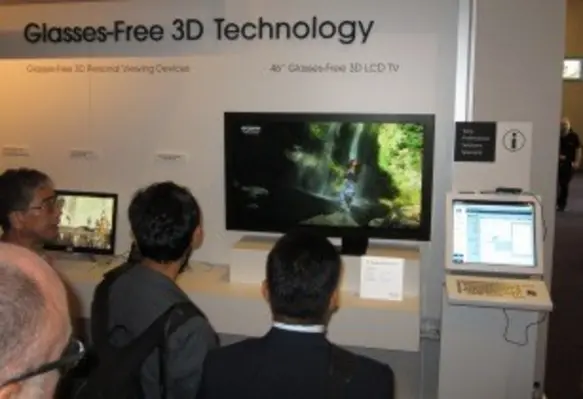Page 2 of 3
With so many new products to choose from, I have concentrated in the following summary on equipment which is technically innovative or, no less important, competitively priced.
AJA Video Systems introduced Ki Pro Quad, a new solid-state portable video recorder capable of capturing edit-ready files in formats including 4K (4096 x 2160), Quad HD (3840 x 2160), 2K (2048 x 1080), and HD (1920 x 1080) with 10-bit 4:4:4 and 10-bit 4:2:2 colour support.
It accepts RAW camera output via SDI, simultaneously forwarding the data via Thunderbolt. The recorder also performs debayer processing of the RAW data which can be used to produce Apple ProRes recordings on SSD media. HD, 2K and 4K ProRes files recorded to SSD can be used in a variety of popular non-linear editors. The debayered image produced by the Ki Pro Quad can also be used for 4K monitoring in real time. A scaled or cropped output is also simultaneously available for 2K or HD monitoring via dedicated SDI and HDMI connections.
Aviwest chose IBC2012 for the European launch of its DMNG PRO 3G/4G-LTE live video uplink system which is designed for worldwide professional use in broadcast newsgathering. It is controlled via an embedded touchscreen or from an AVIWEST smartphone application and can be directly attached to a camera using a standard V-mount or Gold-Mount plate. It allows journalists to combine a variety of network interfaces. These include eight embedded 3G/HSPA+/4G-LTE modems with a high-efficiency custom antenna array providing faster network acquisition and improved resilience; a built-in Wi-fi modem; two auxiliary USB ports and dual Gigabit Ethernet for BGAN or Ka-Sat.
Blackmagic Design introduced a variant of its Cinema Camera with a passive Micro Four Thirds lens mount. The new model supports any Micro Four Thirds lens with manual iris and focus and can be adapted to other lens mounts such as PL via third-party adapters.
Camera Corps launched the new DS-1 remote head which is designed for use with digital single-lens-reflex cameras. Pan, tilt, zoom, pre-shoot and trigger can all be performed using a compact panel with a responsive joystick and pushbutton controller. Images can be viewed at any time during the creative process via a standard Ethernet or USB link from the camera to a desktop or laptop computer.
Canon exhibited its new EOS C100 camera which uses the company's Super 35 mm Canon CMOS sensor and the DIGIC DV III Image Processor of the C300. It records at 24 megabits per second via an integral AVCHD codec. Additional features include HDMI output with embedded timecode, support for external recorders, remote operation, and complete manual control over video and audio recording. Price is expected to be around UK£5,000 (US$8,100).
Cel-Soft introduced Broad-server, a new range of computers tailored for highly demanding broadcast applications such as its Cel-Scope3D stereoscopic signal analyser or Reel-Check QC. Compatible with Microsoft Windows 7 Professional or Linux, it is a 4U rack-mountable system including 4 slots which can be populated with capture cards for video input and output to match user-specific requirements.
An optional eight-inch colour LCD touch-screen on the front panel allows engineering staff to access set-up and monitoring facilities and supervise system activity. The screen can also be used as the user interface for certain types of software. The base model, Broad-server-PC CXS-7680, is configured with an Intel i7-3930 6/12 core processor, an Nvidia GTX680 graphics processor with triple display output, 16 gigabytes of RAM and a four terabyte internal RAID.
EVS’s new C-Cast video server allows clips or highlights created during live productions in outside broadcast or studio facilities to be forwarded rapidly to internet-connected subscribers. Descriptive metadata as well as third-party statistics can be integrated into the C-Cast database and associated to video clips and highlights to facilitate content retrieval for the end user.
Eyeheight's new AD-2EM audio descriptor enables broadcasters of high-definition television programmes to monitor pre-encoded data containing audio and pan/fade information. Designed for use in master control rooms and playout suites, IT decodes audio description and control data from audio embedded in the HD-SDI transport stream. It generates an in-vision display of audio level, fade and pan information. A mix of audio description and programme audio is provided on embedded group 1, channels 3 and 4, with correct pan and fade response.
For-A promoted its new FT-1 as the world’s first full 4K super slow-motion camera. With a high-sensitivity CMOS colour sensor, it captures images at up to 1,000 frames per second and replays 4096 x 2160 ‘super slomo’ video. Uncompressed images are stored to an internal RAM with an 8.5 second capacity. This data can then be transferred to one of two hot-swappable SSD cartridges. Each cartridge will store 75 seconds of full 4K images, enabling up to 150 seconds with the maximum of two SSD cartridges. The camera can simultaneously record and playback in full 4K. Two outputs are presented as 4K via four 1080p HD-SDI outputs along with two down-converted HD-SDI versions for live viewing and the control menu.
Continues on Page 3...























